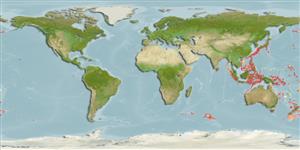Teleostei (teleosts) >
Anguilliformes (Eels and morays) >
Muraenesocidae (Pike congers)
Etymology: Gavialiceps: Hindi, ghariyal = gavial, saurian of Ganges, 1825 + Greek, kephale = head (Ref. 45335); javanicus: Named after its type locality (Ref. 44791).
Environment: milieu / climate zone / depth range / distribution range
Ecology
Marine; bathydemersal; depth range 560 - 600 m (Ref. 44791). Deep-water
Indo-West Pacific: Java, Indonesia and northwestern Australia.
Size / Weight / Age
Maturity: Lm ? range ? - ? cm
Max length : 89.0 cm TL male/unsexed; (Ref. 44791)
Short description
Identification keys | Morphology | Morphometrics
Dark brown, the back is darker than the belly. Peritoneum, gill and mouth cavities are dark and show through the skin. Stomach is bright, does not reach above the anus, its length is 2.1 times the length of the head (Ref. 44791).
Life cycle and mating behavior
Maturity | Reproduction | Spawning | Eggs | Fecundity | Larvae
Karmovskaya, E.S., 1994. Systematics and distribution of the eel genus Gavialiceps (Congridae) in the Indo-West Pacific. J. Ichthyol. 34(3):73-89. (Ref. 44791)
IUCN Red List Status (Ref. 130435: Version 2024-1)
Threat to humans
Harmless
Human uses
Tools
Special reports
Download XML
Internet sources
Estimates based on models
Preferred temperature (Ref.
123201): 2 - 8.8, mean 7.6 °C (based on 26 cells).
Phylogenetic diversity index (Ref.
82804): PD
50 = 0.5313 [Uniqueness, from 0.5 = low to 2.0 = high].
Bayesian length-weight: a=0.00155 (0.00068 - 0.00355), b=2.92 (2.72 - 3.12), in cm total length, based on LWR estimates for this (Sub)family-body shape (Ref.
93245).
Trophic level (Ref.
69278): 3.9 ±0.6 se; based on size and trophs of closest relatives
Resilience (Ref.
120179): Medium, minimum population doubling time 1.4 - 4.4 years (Preliminary K or Fecundity.).
Fishing Vulnerability (Ref.
59153): High vulnerability (56 of 100).
